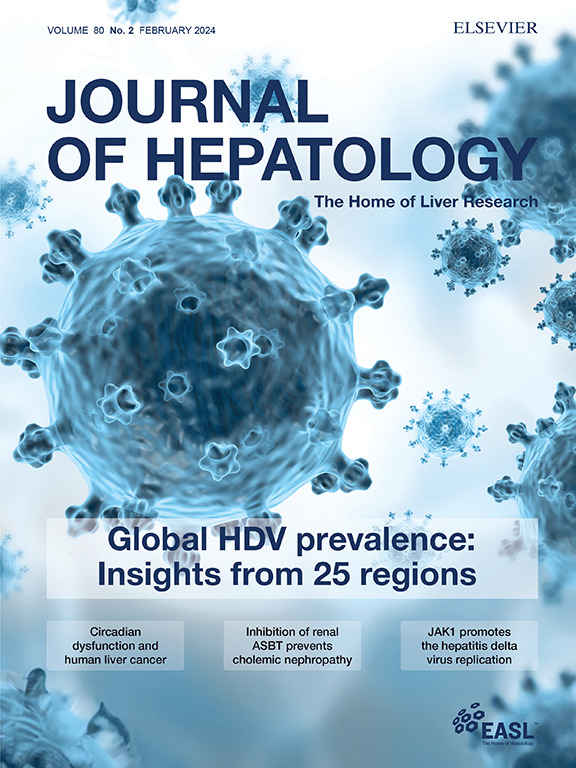Clinical and Pathophysiological Characteristics of Non-acute Decompensation of Cirrhosis
IF 26.8
1区 医学
Q1 GASTROENTEROLOGY & HEPATOLOGY
引用次数: 0
Abstract
Background & Aims
The heterogenous presentation patterns in decompensated cirrhosis confers variable outcomes. While acute decompensation (AD) is well-characterised with poorest prognosis, presentation as non-acute decompensation (NAD) remain unclear. This study aimed to characterize clinical and pathophysiological features of NAD in comparison with healthy (HC), compensated cirrhosis (CC) and AD and identify predictors of progression in NAD.Methods
A prospective, two-center study enrolled patients across the cirrhosis spectrum from India between 2020-2023: CC (n=29), NAD (n=311), AD (n=201), and HC (n=10). Clinical and laboratory parameters, cytokine levels (IL-6, TNF, IL-10, MCP-1), and cell death markers (M30, M65, Gasdermin-D, Receptor-interacting-protein-kinase; RIPK3, Mixed lineage kinase domain-like; MLKL) were assessed at baseline. Patients were followed for 12 month-survival. The predictors of progression to AD and mortality were evaluated in NAD.Results
Patients with NAD had a poorer survival (81.7%) compared to CC (100%), but superior to AD (31.2%) (p<0.001). Despite no significant systemic inflammation, patients with NAD exhibited elevated levels of cell death markers, particularly Gasdermin-D and RIPK3, compared to healthy and patients with CC. Both inflammatory and cell death markers were most pronounced in AD. Over 12 months, the cumulative incidence of progression to AD among NAD was 55.1%, significantly reducing their survival (68.2% vs. 95.3%, p<0.001). Predictors of such progression to AD included severe ascites, lower IGF-1, albumin, BMI, and higher bilirubin, CTP, MELD, Gasdermin-D, and RIPK3 levels.Conclusions
NAD represents a clinically, prognostically and pathophysiologically distinct entity in cirrhosis. Patients with NAD express elevated cell death markers and remain at risk of progression to AD and mortality. Identifying such high-risk patients should prompt interventions to prevent progression. Modulation of cell death is a potentially disease-modifying target in cirrhosis.Impact and Implications
This study highlights non-acute decompensation as a clinically, prognostically and pathophysiologically distinct subset of cirrhosis, underscoring the importance of understanding its progression dynamics. Identifying key predictors of acute decompensation, including ascites severity, low IGF-1 levels, and elevated cell death markers such as Gasdermin-D and RIPK3, potentially suggests new therapeutic avenues. These findings are crucial for hepatologists and researchers in risk stratifying patients and optimizing transplant candidacy. Interventions targeting necroptosis and pyroptosis pathways may improve outcomes, providing a significant shift towards precision medicine in cirrhosis care.

肝硬化非急性代偿失代偿的临床和病理生理特点
背景,目的失代偿期肝硬化的异质性表现模式导致了不同的结果。虽然急性失代偿(AD)的特点是预后差,但表现为非急性失代偿(NAD)仍不清楚。本研究旨在将NAD的临床和病理生理特征与健康(HC)、代偿性肝硬化(CC)和AD进行比较,并确定NAD进展的预测因素。方法一项前瞻性、双中心研究纳入了2020-2023年印度肝硬化患者:CC (n=29)、NAD (n=311)、AD (n=201)和HC (n=10)。临床和实验室参数、细胞因子水平(IL-6、TNF、IL-10、MCP-1)和细胞死亡标志物(M30、M65、Gasdermin-D、受体相互作用蛋白激酶;RIPK3,混合谱系激酶结构域样;MLKL)在基线时进行评估。随访患者12个月。在NAD中评估进展为AD和死亡率的预测因素。结果NAD患者的生存率(81.7%)低于CC(100%),但优于AD (31.2%) (p<0.001)。尽管没有明显的全身性炎症,但与健康和CC患者相比,NAD患者表现出细胞死亡标志物水平升高,尤其是Gasdermin-D和RIPK3,炎症和细胞死亡标志物在AD中最为明显。在12个月的时间里,NAD患者进展为AD的累积发生率为55.1%,显著降低了他们的生存率(68.2% vs. 95.3%, p < 0.001)。这种进展为AD的预测因素包括严重腹水、较低的IGF-1、白蛋白、BMI和较高的胆红素、CTP、MELD、Gasdermin-D和RIPK3水平。结论snad在肝硬化中具有临床、预后和病理生理上的独特性。NAD患者表达升高的细胞死亡标志物,并仍有进展为AD和死亡的风险。识别此类高危患者应及时采取干预措施以防止病情恶化。调节细胞死亡是肝硬化中一种潜在的疾病修饰靶点。影响和意义本研究强调了非急性失代偿作为肝硬化临床、预后和病理生理上独特的亚群,强调了了解其进展动态的重要性。确定急性失代偿的关键预测因素,包括腹水严重程度、低IGF-1水平和细胞死亡标志物(如Gasdermin-D和RIPK3)升高,可能提供新的治疗途径。这些发现对于肝病学家和研究人员对患者进行风险分层和优化移植候选资格至关重要。针对坏死性上睑下垂和焦上睑下垂途径的干预可能改善结果,为肝硬化护理提供了向精准医学的重大转变。
本文章由计算机程序翻译,如有差异,请以英文原文为准。
求助全文
约1分钟内获得全文
求助全文
来源期刊

Journal of Hepatology
医学-胃肠肝病学
CiteScore
46.10
自引率
4.30%
发文量
2325
审稿时长
30 days
期刊介绍:
The Journal of Hepatology is the official publication of the European Association for the Study of the Liver (EASL). It is dedicated to presenting clinical and basic research in the field of hepatology through original papers, reviews, case reports, and letters to the Editor. The Journal is published in English and may consider supplements that pass an editorial review.
 求助内容:
求助内容: 应助结果提醒方式:
应助结果提醒方式:


